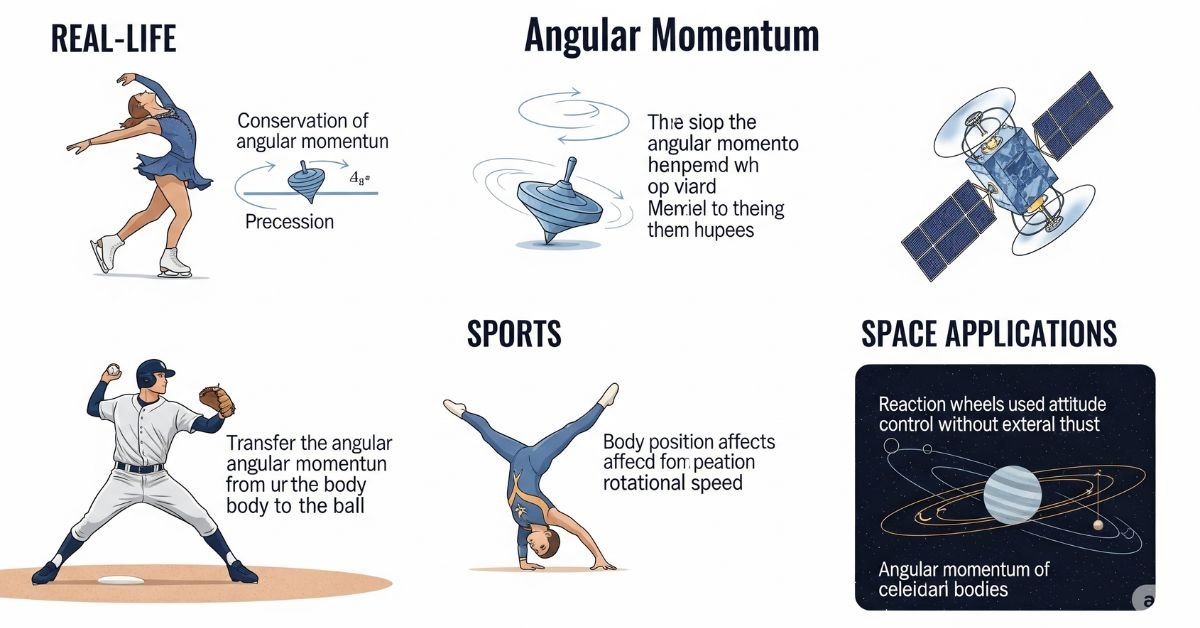Examples of angular momentum abound in everyday life. From a top spinning to the rotation of the Earth in the universe, this basic physics principle is always in action. It explains why skaters reach higher rotational velocities when their arms are pulled inwards and why planets maintain their orbital trajectories around the Sun.
Simply put, angular momentum can be defined as the “spin power” of a moving object. Its value depends on the mass of the object, the speed of its spin, and the radius of the spin from its axis. Understanding this principle belongs not only to scientists, but it can be seen in a variety of fields like sports, engineering, space travel, and even in one’s kitchen.
Core Concepts of Angular Momentum
Angular momentum is a measure of how much rotation an object has. It depends on two main things: the object’s moment of inertia and its angular velocity. The moment of inertia is like rotational mass. It tells how hard it is to start or stop an object’s spin. Angular velocity is how fast it spins.
There are two main kinds. Spin angular momentum happens when something rotates around itself, like Earth spinning on its axis. Orbital angular momentum happens when something moves around another object, like the Moon orbiting Earth. Both follow the same principle: if no outside force acts, the angular momentum stays constant.
Read More About : How to Add Angular Features to the Project
Types of Angular Momentum
Physics divides angular momentum into three main types. Spin angular momentum is when a body rotates around its center, like a spinning basketball. Orbital angular momentum is when the center of mass follows a circular path, like the Earth going around the Sun. Total angular momentum is the sum of both types when they happen together, as with satellites that rotate while orbiting.
Understanding the types helps in real-world applications. Engineers use spin angular momentum in designing gyroscopes. Astronomers use orbital angular momentum to explain planet motion. Together, these concepts shape much of science and technology.
Everyday Life Examples of Angular Momentum
You can see examples of angular momentum without going to a science lab. A spinning ceiling fan is one of the simplest. The fan blades keep spinning unless friction slows them down. A potter’s wheel works the same way when shaping clay.
Even small actions show it. A child spinning on a playground ride speeds up by pulling in arms or legs. Opening a door also uses angular momentum, with the hinges acting as the axis of rotation. Bicycle wheels stay stable while moving because of their spinning motion.
Sports Examples of Angular Momentum
Sports are full of examples of angular momentum. In gymnastics, athletes use body rotation to perform flips and twists. Once in motion, they can adjust their body shape to control speed. Figure skaters pull their arms in to spin faster. Divers do the same when tucking into a somersault.
In cricket and baseball, pitchers and bowlers rely on rotational motion to deliver powerful throws. A quarterback in football throws a spiral pass that remains stable because of angular momentum. The same principle helps Frisbees fly straight.
Astronomy and Space Examples
Space offers the largest-scale examples of angular momentum. The Earth rotates around its axis once every 24 hours and revolves around the Sun once a year. The Moon orbits Earth due to orbital angular momentum.
When stars collapse into neutron stars, their rotation speeds increase dramatically. This is because their mass moves closer to the center, reducing the moment of inertia but conserving angular momentum. Accretion disks around black holes spin rapidly, powered by the same principle.
Astronomy Examples of Angular Momentum
| Object | Type of Angular Momentum | Example Speed |
| Earth | Spin & Orbital | 1,670 km/h spin |
| Moon | Orbital | 3,680 km/h orbit |
| Neutron Star | Spin | Up to 700 rev/sec |
| Accretion Disk | Orbital | Near light speed |
Engineering and Technology Applications
Engineers design machines using examples of angular momentum for stability and motion control. Flywheels store energy by spinning at high speeds. They power machines when needed. Gyroscopes help aircraft, ships, and smartphones detect orientation.
Spacecraft use reaction wheels to adjust position without fuel. Wind turbine blades rotate to turn wind energy into electricity. Helicopter rotors rely on controlled angular momentum to remain stable and lift off.
Conservation of Angular Momentum
The law of conservation of angular momentum says that if no outside torque acts, the total angular momentum stays constant. This explains why a spinning skater speeds up when pulling arms in. The smaller the radius, the faster the spin, to keep momentum constant.
In space, the same principle guides spacecraft maneuvers. Astronomers believe planets formed from rotating clouds of gas and dust that kept spinning as they condensed.
You Might Be : Angular vs jQuery, React, and Vue.js: A Detailed Comparison for 2025
Conservation Examples
| Situation | Radius Change | Speed Change | Reason |
| Skater pulling arms in | Decrease | Increase | The moment of inertia decreases |
| Neutron star formation | Decrease | Increase | Mass collapses inward |
| An ice skater stretching out | Increase | Decrease | The moment of inertia increases |
Formula and Calculations
The basic formula for angular momentum is:
L = I × ω
Where:
L = Angular Momentum
I = Moment of Inertia (kg·m²)
ω = Angular Velocity (rad/s)
The units are kilogram meter squared per second (kg·m²/s). This formula works for simple rotating bodies, but complex shapes require more detailed calculations.
Example Angular Momentum Calculations
| Object | I (kg·m²) | ω (rad/s) | L (kg·m²/s) |
| Ceiling Fan | 0.6 | 10 | 6 |
| Bicycle Wheel | 0.8 | 15 | 12 |
| Skater Spin | 2.0 | 8 | 16 |
Common Misconceptions
Many people think faster speed always means higher angular momentum. In reality, it also depends on mass and radius. A light spinning coin may have less angular momentum than a slowly turning heavy wheel.
Another mistake is believing gravity creates angular momentum. Gravity can change direction or speed, but does not create it. Also, in an isolated system, angular momentum cannot be lost—it can only be transferred.
FAQ” s
What is angular momentum in simple words?
It’s the amount of rotation an object has, based on its mass, spin speed, and how far the mass is from the center.
Can angular momentum be lost?
Not in an isolated system. It can only change if an outside torque acts on it.
What are some real-world uses of angular momentum?
Flywheels in machines, gyroscopes in navigation, and reaction wheels in spacecraft.
Why do skaters spin faster with arms in
Pulling arms in reduces moment of inertia, so spin speed increases to conserve angular momentum.
Is angular momentum only in circular motion?
Yes, it applies to rotation or orbiting motion, not straight-line movement.
Conclusion
The examples of angular momentum we see daily—from spinning fans to orbiting planets—illustrate the power and universality of this law. It connects kitchen tools, sports, engineering, and astronomy under one principle. Whether it’s an ice skater’s spin or the Earth’s rotation, the same rule applies: keep the spin unless something changes it. Understanding it not only explains motion but also drives technology and exploration forward.




